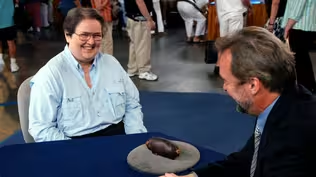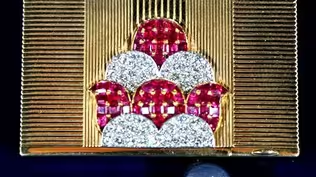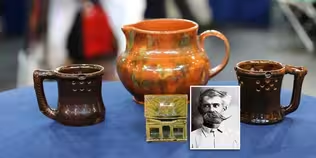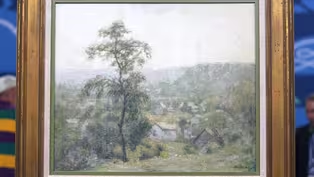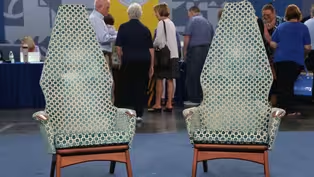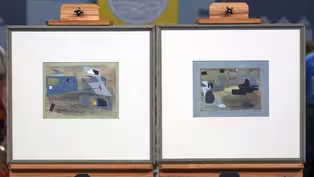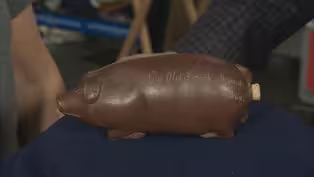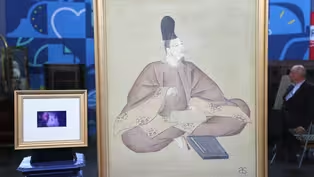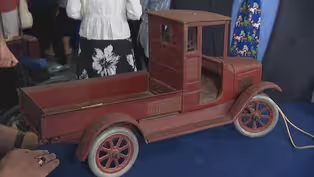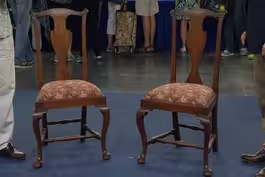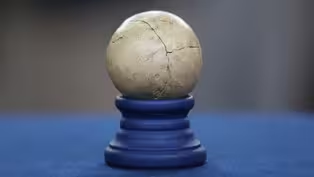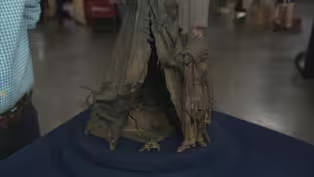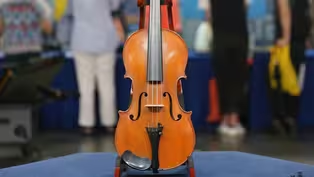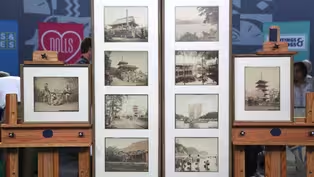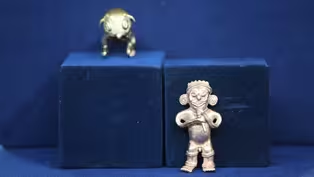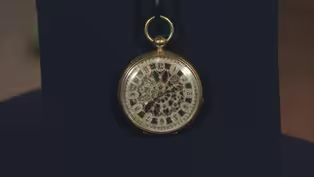
New Orleans, Hour 2
Season 22 Episode 5 | 52m 31sVideo has Closed Captions
Voyage with ROADSHOW to the Crescent City for incredible stories and items!
Voyage with ROADSHOW to the Crescent City for incredible stories and items, including a "Blade Runner" set decoration, Agnes Martin mixed-media abstractions, circa 1955, and a feather golf ball from around 1840. Can you guess which was appraised at $40,000-$80,000?
Problems playing video? | Closed Captioning Feedback
Problems playing video? | Closed Captioning Feedback
Funding for ANTIQUES ROADSHOW is provided by Ancestry and American Cruise Lines. Additional funding is provided by public television viewers.

New Orleans, Hour 2
Season 22 Episode 5 | 52m 31sVideo has Closed Captions
Voyage with ROADSHOW to the Crescent City for incredible stories and items, including a "Blade Runner" set decoration, Agnes Martin mixed-media abstractions, circa 1955, and a feather golf ball from around 1840. Can you guess which was appraised at $40,000-$80,000?
Problems playing video? | Closed Captioning Feedback
How to Watch Antiques Roadshow
Antiques Roadshow is available to stream on pbs.org and the free PBS App, available on iPhone, Apple TV, Android TV, Android smartphones, Amazon Fire TV, Amazon Fire Tablet, Roku, Samsung Smart TV, and Vizio.
Buy Now
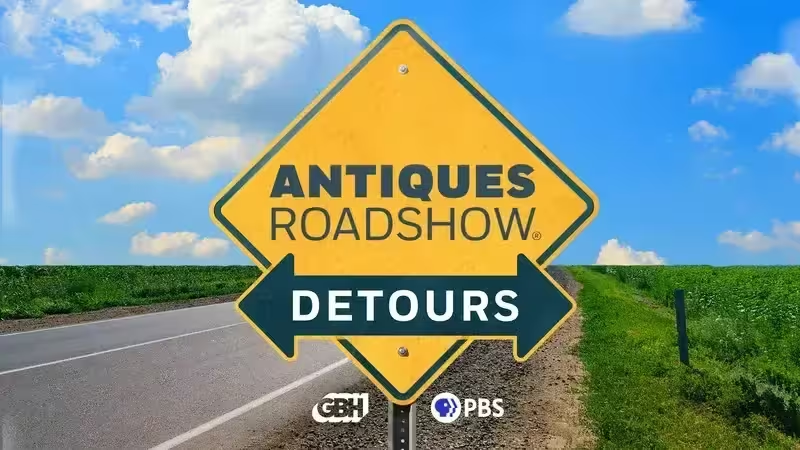
ANTIQUES ROADSHOW DETOURS
Ever wondered what happens to the treasures featured on America’s beloved ANTIQUES ROADSHOW after the cameras leave town? Host Adam Monahan tracks down the juicy afterlives of your favorite finds from PBS’s hit series.Providing Support for PBS.org
Learn Moreabout PBS online sponsorshipMARK WALBERG: "Antiques Roadshow" is turning up treasures in New Orleans.
WOMAN: My great-grandmother's sister married George Ohr.
Whoa, really!
Got a lot of jealous nerds out there who would love to see this in their home!
♪ ♪ WALBERG: New Orleans, the birthplace of jazz.
And the birthplace of jazz legend Louis Armstrong.
This is Armstrong's first cornet, on display at the New Orleans Jazz Museum.
See the grooves carved into the mouthpiece?
It's been said that Armstrong did this to improve his lip grip and get a better sound from the instrument.
Back at the Roadshow, the sound of excited collectors is music to our ears.
How does this guest react to news about her movie set piece?
Let's find out.
It's a piece that my husband purchased out of California, through the internet, back in the year 2000, from set designers who did the set for "Blade Runner," which was everybody's favorite movie, still now.
My husband was a big movie buff.
He was also in television, as well as public affairs.
As far as people you knew, and were with, they were people who graduated from movie schools in California.
Movies like "Blade Runner" were uppermost.
When he saw or heard that this picture was for sale, he went on the internet.
My husband made an offer, they accepted it.
Do you know what he paid for it back in 2000?
Yes, it was about $2,650 with shipping.
We've had it hanging in our home, and we think it's a fine painting, regardless of "Blade Runner," but with "Blade Runner" and everybody's love of it, that makes it really exciting.
Yes, now the question is how exciting, and that's where I come in.
This has what we call a "cult following," so any time you have a piece that's associated with a cult following, it means we can go pretty deep into the film to find things that people are going to be interested in.
And what I mean by that is, sometimes if it's a film that there's a spare number of people out there who like it, you need to have really key props in order to get some really serious interest in it.
Other times, what we call "set dec," which this would be considered, set decoration, and oftentimes, we say set dec's not as interesting to collectors, just because it's in the background, and they don't really interact with it so much, but you see it.
You do see this painting.
It's in Harrison Ford's apartment in the film, as he plays Rick Deckard.
And you can see it pretty clearly in the scene where he's kissing Sean Young, so that's great.
The most expensive thing that's ever come out from this film was actually the hero gun that Harrison Ford used in, the blaster, that sold for $225,000, and that was in 2009.
We had one of the painting specialists take a look at it, and she believes it may actually be a mixed-media piece.
She thought-- it's possibly an enhanced print done with some paint and pigment.
We're not exactly sure, but what they told us was, as a painting, it's probably not too old, it's probably from the 1950s or '60s.
And it's probably not worth more than $500 to $700 as a painting, which, I know that you had a copy of the invoice from the set decorators when they bought it from a gallery in Beverly Hills in 1981, in preparation for this 1982 film.
And they paid $720 and change for it back then.
Given the fact that this is such a cult classic, today, at auction, we would expect this to sell between $10,000 and $15,000.
Now that's-- that is really exciting.
That is truly exciting.
You know, when you hear people say they had no idea.
And I really didn't, so this is a marker.
This is wonderful.
Wonderful.
I'm thrilled.
You've got a lot of jealous nerds out there who would love to see this in their home.
Well, could be theirs, at some point.
WOMAN: My mother gave me these, but she got them from her mother.
My great-grandmother's sister married George Ohr.
APPRAISER: Wow.
And so these were made by?
George Ohr.
So they've been in the family all that time.
Did you ever meet any of his family, did you ever go there?
Yes.
I met what I believe was his daughter.
They lived out in the country, and I went with my mother and my aunt.
And I remember, like, a house and a barn, maybe a barn setting.
It was a rural setting.
Sure.
And I saw, like, shelves of pottery, and I went inside their house for a little while.
It wasn't any mansion, that's for sure, it was just regular people.
The pottery-- was there a lot of it?
Could you see it?
Did you have any memories of that?
Yes, and from what I can remember, it was, like, on tables and it was on shelves.
It was everywhere.
Just stacked everywhere.
Yes, sir.
And the family just didn't think much about it.
No.
They did not-- isn't that interesting?
Tell me about these pieces, here.
Well, as far as I know, I have a rabbit-ear puzzle mug, then that particular puzzle mug, it's got a strange kind of etching on the handle itself.
And then the little house over there is an inkwell.
Yes, that's correct.
And then a pitcher.
Okay.
George Ohr made lots of puzzle mugs.
A puzzle mug has little holes in the handles and in the rim, but there's a hole at the bottom of the handle.
And so, to drink out of it, you tilt the mug, and then you have to put your fingers over certain holes, and then you can usually suck one of the holes and get the liquid out.
But you have to know the puzzle.
And I don't know what it is.
(laughs): Okay.
But there is a trick to drinking out it without spilling it, so that's why it's called a puzzle mug.
And then the pitcher is a little unusual for George Ohr, in that it's really utilitarian.
Most of his stuff was decorative, and this is kind of interesting because he didn't use a lot of color in that way.
What I really love about the inkwell is, it's the shape of a house, exactly what was like in his community, with even doors and windows, the roof line, and I think it's a really interesting design that he made it like that.
Now, there's a number of different marks that he used, and one of the examples of the marks is actually on the house.
He just scratched, in hand, he put "Biloxi."
He also sometimes signed by hand.
So this one has his name, George Ohr, which he signed in script.
And the other two have the same mark, the impressed mark.
So it was, like, a little die stamp that he pressed into the clay with his name and Biloxi, so that's the third mark that he used.
Now, the date of all these pieces, they were made by George Ohr between about 1895, about 1900.
What year were you there?
'59, '60.
Okay.
Possibly.
Yeah, in about 1969, a man came down from the Northeast and bought most of that pottery, and hauled it off, so you saw it before he hauled it all off.
The mugs-- you could look online and see some kind of high prices, and the prices on Ohr has fallen a little bit.
In some cases more than others.
But since those are relatively common, actually, these days, they only sell for normally around $500 to $750 apiece.
The pitcher has a few little damages, which is not that unusual for Ohr.
A lot of it does have a little damage.
We wish it didn't, it would be worth a little more.
But it would still probably be worth between $1,250 and $1,750.
And then the inkwell is the best piece.
And that one would probably sell for at least $2,500 to $3,500, and so the collective total would be somewhere between $4,750 and $6,750.
Okay.
However, if it went to auction, the family connection, the provenance, might bump the price up a little bit more.
I see.
How much do you think all that pottery is worth now that you were looking at... That I was looking at then?
Millions.
You got it.
Millions.
We talked about it, I talked about it with some of the other appraisers, and we estimate all that pottery is now worth somewhere between $50 million and $100 million.
Wow, that's a lot of money.
As a little girl, if you had known that... (laughing): Yeah.
I lived in New Orleans for Katrina.
Okay.
And so we got to come back sooner than most people because our house didn't flood.
And so we're walking, just checking out-- and this was sitting out in the garbage.
In its condition right now, it is worth around about $25 to $50.
If you clean it up, it is $25 to $50 plus the elbow grease that you put into it.
Plus the cost of cleaning it.
Yes, exactly-- all right?
Well, thank you.
WOMAN: The story was, was that it belonged to a blind man from India, and he would sit in his garden and he would stroke her, because she's really smooth.
It looks more American.
It looks like it was probably made in the 1950s or 1960s.
Very nice Modernist interpretation.
And it's really a charming piece.
Are you a train person?
No.
I was getting it for my son, for his bedroom.
My mother still buys me stuff like this.
How much did you pay for it?
Nothing.
You paid nothing, you made some money.
Probably looking at about $10, $25.
It's a cute little train.
WOMAN: As a child, my father saw his grandpa go to the mantel, pick the pig up, uncork it, take a swig of whiskey, put it back on the mantel.
It was made by the Anna Pottery in Anna, Illinois, between mid-1860s to the 1880s.
The Anna Pottery opened in 1859 and closed around the turn of the century.
And it was founded by two brothers: Wallace and Cornwall Kirkpatrick.
They made hundreds of thousands of stoneware pieces, mainly utilitarian, but they also made a bunch of oddball pieces, and one of those oddball pieces were these flasks, these pig flasks.
This flask is an atypical flask for the Anna Pottery pig flask, because it has so little writing on it.
"Some old French brandy in a hog's..." Most of these flasks that were made, were made with an elaborate map of railroads and towns throughout the Midwest, often with Anna, Illinois, as the sort of center.
Your flask is not as good as the railroad flask, because it's got less going on for it, but even so, I would think that the flask is probably valued in today's market, at auction, somewhere between $3,000 and $4,000.
Wow.
That's great!
WOMAN: Well, my grandmother, her name is Virginia, but I call her Jenna, affectionately.
She worked Downtown Atlanta.
She worked for Western Union there, and so she made that trek from where we... We're in a very rural area-- about an hour and a half south, every day.
So before they built the interstates and stuff, she was traveling home from work, and thought she noticed what looked like a pocketbook on the side of the road, so she turned around and went back, grabbed the pocketbook.
And when she got home, inside the pocketbook was three $100 bills, in mid-'50s, so... And this was wrapped up in some tissue.
My grandfather was a policeman at the time, worked for the police department, so they called the police department, took it up there, and I guess they ran it in the paper, whatever they did in those times.
And several months went by, and they released it back to her and it was hers to keep.
No one ever came forward to claim it.
Nothing.
Nothing.
Wow.
What we have here is an American platinum, yellow gold, diamond, and ruby brooch.
Manufactured in America, probably in the 1930s, just after the Art Deco period.
How did you end up with this brooch?
Well, for years I'd heard my mom and my grandmother talk about this bird pin, or whatever, and I was just, like, "I don't know about a bird pin," but when I got married, I needed something to wear on my band, on my wedding dress, and my grandmother said, "Oh, the bird pin will be perfect!"
And I was, like, "I don't know about that."
And so she showed me.
I was, like, "Oh, it's perfect, two lovebirds..." Blah, blah, blah.
So I wore it when I got married.
After I got married, I went to give it back to her, and she said, "Oh, no, it's yours, you keep it," and so I've had it ever since!
Lucky you.
What a nice present.
Well, a few things make this brooch particularly special.
They're all single-cut diamonds, very uniformly matched.
Total carat weight I calculated is about five carats.
You have a beautiful brushed 18-karat yellow gold nest, here.
Very natural-looking, you can see the way that the craftsman overlapped the branches, and it really looks like a natural nest.
Inside, we have three eggs, also set with single-cut diamonds, seated on a branch with one final single-cut diamond on the tip.
So the detail is very exquisite.
It's unsigned, but my guess is that it was one of the better craftsmen in the time making jewelry in America.
The ruby eyes are a really nice detail, yellow gold beaks match, and it just is a really, really sweet thing.
It's a wonderful family piece to have.
If this was to be sold at auction, I would expect it to bring somewhere between $4,000 and $6,000.
Okay.
Super-cool!
For retail, I'd say about double.
Okay.
Maybe $10,000 to $15,000.
Okay.
Awesome!
Well, my grandmother is going to be so excited.
I begged her to come, but she wouldn't come with all us crazy people, she said, but she'll be excited for me to give her the details on it.
She's had it in a coat pocket for years before she gave it to me, so... WOMAN: My father had loaned some money to a relative.
In payment, some years later, the debt, he would receive this painting.
And do you know how much, approximately, that loan was or were there any circumstances around it that you remember being told?
I don't know exactly.
It was, you know, $15,000, $20,000, I think.
Okay.
The artist's name is Adolph Shulz, and Shulz lived most of his life in Brown County, Indiana.
He was really responsible for starting the Brown County school of artists.
Okay.
Shulz spent most of his time in a town called Nashville, Indiana, which is south of Indianapolis.
And it's titled on the back "Looking Over Nashville."
We mistakenly thought it was Nashville, Tennessee.
Nashville is sort of a little-known artists' community in Indianapolis, around the turn of the century.
Shulz exhibited quite a bit at the Hoosier Salon, which was just north of Indianapolis.
It was an art exhibit, once a year, and it was juried.
And he was well-known for his exhibitions there.
And most of his work that is most sought after by collectors are scenes of Nashville.
Okay.
It's an oil on board.
And often, I've seen his work on board.
It tends to hold up relatively well, and not require a great deal of restoration.
It's signed here in the lower right, and it's dated July 29, 1926, and it was probably exhibited shortly after it was painted.
Okay.
The market is not the same as it once was, but a current fair market value at auction, you could reasonably expect a value of $10,000 to $15,000.
Okay, very good.
That would be good.
Does that surprise you?
It does!
At the height of the market, it would have had a value, about ten or 15 years ago, in the $30,000 to $50,000 range.
Okay.
WOMAN: This is a crazy quilt.
My gosh, it is crazy, isn't it?
Well, I love this type of thing.
I don't know anything about it.
APPRAISER: Horns are not that collectible.
I'd probably put it somewhere between $600 to $1,000, is kind of what I would guess.
APPRAISER: Where'd you pick it up at?
MAN: I bought it from a friend's mom, actually.
How much did you pay for it?
$300?
Considering it's working, and the accuracy is fairly decent, I'd put the value on it about $750.
Excellent.
WOMAN: I found this at a country auction.
My husband and I were shopping for furniture for our home that we had just built, and I spied this beautiful brooch, and I told my husband that I would like to have it.
He said, "No, we're here for furniture.
I don't believe we're going to buy jewelry today."
But I prevailed, and he decided yes, we would stay and see what it would go for.
And I got it.
So why did you want to buy it?
I could see that it was a nice piece.
And then when I turned it over, I saw the stamp of Van Cleef & Arpels.
This is indeed by Van Cleef & Arpels.
But it's from France, not New York, which makes it more desirable.
This is the kind of jewelry that costume jewelry copied.
It is a double-prong fur clip, in 18-karat yellow gold.
It has cushion-cut cornflower blue Ceylon sapphires.
Oh, really-- oh.
15 carats of those.
Oh.
It has Burmese rubies, about 3.6 carats of those, and it's just gorgeous.
It's from the 1940s, when women were wearing the fur clips, or the double-prong clips, on their heavier fabrics.
So what did you end up paying for the pin?
It was about $1,200.
And when was this?
This was 1971 or '72.
The retail value of this piece in today's market is $35,000.
Oh, Rosie!
(laughs) That's great.
I'm so, I'm delighted.
Thank you!
Thank you.
MAN: I found this in an antique store in 1971 in Virginia.
And because I was interested in golf and collecting golf items, I not only bought that golf ball, but several wood shaft clubs at the same time.
And when you bought it, what did you know about it?
I had read in some antique books about golf, about how they made feathery balls, using a top hat to measure the feathers, and how they boiled them in steamy water and stuffed them in the ball.
So that made it very interesting to me at that time.
And what did you pay for this?
$200.
And you recognized this as a feather ball.
Yes.
You bought the hickory-shafted clubs, right?
The wooden-shafted clubs, and you bought the ball.
Did you play with them?
Oh, I wanted to so many times, but after reading in the books, I found out that they're only good for about six holes of golf, and they would tear and explode.
And I didn't want that to happen with a $200 golf ball.
That's an expensive round of golf.
Yes.
Feather balls were used until about 1850 or so, and they were used with the long-nosed, wooden-shafted clubs that were made in Scotland.
And these emanate from Scotland, because Scotland is considered by many to be the home of golf.
You said something about how they made the golf balls.
You're absolutely right in many ways.
These are leather-covered feather balls.
There are literally feathers in the ball, and the leather is usually from bull's hide, believe or not.
What you would do is, you would take the bull's hide, cut it into strips, and then you would reassemble three different pieces, and you have a flap, and you would turn it inside-out, and you would measure an actual top hat and put the feathers in.
In those days, a good feather ball maker could only make three to ten balls a day.
It was very labor-intensive, and because of that, the balls were hugely expensive, so it was a sport only for the wealthy.
This feather ball dates from the, probably, 1830s, maybe up to 1850 or so.
You know what happened to the feather ball is that they discovered they could use gutta-percha, which was from a gum tree in Southeast Asia.
Much more durable, much easier to make, and therefore much less expensive.
So with the advent of the gutta-percha ball, it became a sport much more for the middle classes.
These balls, you could hit 100 yards, maybe 150 yards.
That was about the limit.
If you were a really good golfer, you could hit it 200.
How far can you hit a regular golf ball today?
I have hit a golf ball 300-plus yards, but typically about 280.
And your pros today can hit over 300 yards.
They estimate that today, only several hundred of these exist.
They're very well sought-after.
They're highly desired by collectors.
If I were going to put an auction estimate on this today, I would probably put about $4,000 to $6,000.
Oh, wow, very nice.
The height of the market hit about ten, 15 years ago, and at that time it could have even been as much as $15,000 to $20,000.
Wow.
I know.
But still, $4,000 to $6,000 is pretty good.
Still good.
It belonged to my great-grandmother.
She was a musician, took music when she was a child, and later on in life was a music teacher.
Do you think she used this one as a child?
I don't know, I know that was the one she had as an adult.
Well, this is a classy little fiddle.
Is it?
This was made in the town of Mirecourt in France, which is where most of the violins in the 19th century were made in France.
It could have been made by any number of, three or four or five, commercial workshops.
Not just one guy making one violin.
I think this was made about 1880, maybe even as late as 1890, and the work is just very classic French.
You see how nicely these corners are formed?
Uh-huh.
Beautiful carving, and I'm going to turn this around, and that's called a button.
And that button is really gorgeous.
It's very small, but beautifully carved.
Back of the head, beautifully done.
And, normally, a child's violin is quickly produced, meant to be a cheap, almost a throwaway item, because it's a stepping stone towards a full-sized violin.
But the real prize for me was seeing this bow, and it's a full-sized bow.
I was surprised to see it with a three-quarter violin.
And it's a bow made in France, also.
I think this was made, perhaps in the town of Mirecourt, as well, but made for the firm of J.-B.
Vuillaume.
I'm going to show you here.
It's got a silver-mounted frog.
That's a silver ferrule, silver bands on the adjuster.
J.-B.
Vuillaume himself was not a bow maker, but he employed the best bow makers in France at the time.
This was made about 1860, 1870, just towards the end of the J.-B.
Vuillaume shop.
He died in 1875.
The violin-- I'd say retail value in a violin shop, $3,500, perhaps $4,500.
The bow is not the esteemed wood which is called Pernambuco wood.
This is what the French call bee's wood, and we call Brazilwood.
And this is not particularly well preserved, but it has a lot of potential.
With, I think, about $1,000 worth of restoration, this would be, perhaps, retail value, $12,000 to $15,000.
Oh, wow.
This bow, I think, may have been made by the bow maker Nicolas Maline.
And he did work for Vuillaume, worked on his own, but also worked for Vuillaume.
The bow, as is, not easy to sell as it is, but I would think between $3,000 and $5,000 as it sits.
If I'm right about the maker.
But I think I am.
Well, all righty.
(laughs) Well, there are two chairs.
It was out of a set of six.
And they've been in the family-- at least the story goes-- since they were basically created.
An old descendant of ours, Isaac Kazanow, worked for John Hancock.
The set of six were a wedding gift to Isaac Kazanow from John Hancock, back in the late 1700s.
Oh, man, that's pretty amazing.
That gets my heart beating.
How long have you been in New Orleans?
Well, I've been in New Orleans for two years now, but my folks lived over on the coast in Bay St. Louis, and these chairs we had in the dining room, and they went through Katrina.
Folks had eight feet of water in the house.
You can still see some of the Katrina dirt.
Oh, my God.
And if we look at the back rail, you can see how light it is, and I wondered-- it seemed like there was water damage or some sort of moisture, so that explains it.
So these chairs are really true survivors.
These are, in fact, what we call Chippendale mahogany dining chairs.
They would've been made in the North Shore of Massachusetts, just north of Boston.
Okay.
And one of the indicators is, overall, what's the design?
It's a nice, clean aesthetic.
You've got this wonderful serpentine crest with...
I love these flaring, molded ears.
At center, there's a nice vasiform splat, continues to a trapezoidal seat, and we've got these wonderfully shaped, beautiful line-of-beauty type cabriole legs that end in a pad foot with a nice cushion or disk.
This disk or cushion is what is the indicator that these were not made in Boston, but likely the North Shore.
You're talking Salem, Ipswich, Newburyport.
They were likely made between about 1760 and 1780.
Have you ever had the chairs appraised?
Do you have any sense of value or...?
No, we use them around the house for the dining room chairs and never had them appraised.
Well, using them is just what I like to hear, because they're awesome.
This furniture was made to last.
They've had standard wear.
What do you expect for 200 years?
And you see this wonderful surface, it's got this rich brown color.
If I were to estimate the pair of chairs at auction, I would say $1,000 to $2,000.
Okay.
Now, if you could substantiate the Hancock evidence, if you can find any sort of documentation, like a letter or things in a will that indicate Hancock owned these, there's an exponential factor.
I would say, for the pair, I think I would conservatively estimate them at $20,000 to $40,000 at auction.
Wow.
APPRAISER: Because she's so pristine and with everything, around $125, $150.
WOMAN: Oh, okay.
So, good little treasure hidden away in a box.
Yeah.
Thank you for coming to the show.
Sure.
Especially, like, shops that specialize in Afghani goods, it would be in the $600 to $1,000 range.
So I'm going to keep this on my floor and love it.
Absolutely, use it and enjoy it.
MAN: I actually got it for my daughter.
She had just been born.
Be quite a memento for your daughter.
She doesn't even know I have it.
These are made on an assembly line.
But it's tour de force.
It's fantastic.
It's really wonderful.
WOMAN: I bought this watercolor in 1975 because I think it spoke to me about rural Louisiana, which is my home.
I hung it in the hall in a very obscure place because I was-- didn't really didn't want my husband to see it right away.
And he didn't see it for about eight months.
And then when he did see it, it was quite a surprise, but... (laughs) I kind of hid it from him.
Here is the signature, Lloyd Hawthorne, and it's dated 1975.
Which is the same year that you bought it.
Yes.
How much did you pay for it, then?
$150.
He actually is from Pineville, Louisiana.
Yes, he is.
And he was in World War II.
He started his artistic career in the military as a medical illustrator, and then he worked at the Louisiana Electric Company as a draftsman and artist.
But he would frequently take breaks and go study art at LSU.
This picture is a lovely example with the Louisiana landscape and these figures.
It's in great condition.
I think if this were to be offered in a retail gallery, the asking price might be about $2,500.
Oh, really!
Really.
I made some money!
Yeah!
WOMAN: I brought you a clock that's been in my family for many, many, years.
Longer than I have.
It was my godmother's, and she lived in New Orleans.
And I was her favored child-- she had no children.
And so when she passed on, in her will, she left me many items and this was one of them.
Her husband was from France, so it could have some French influence, but I'm not aware of anything like that.
I'm totally ignorant.
So you have to tell me all the goodies about it.
Well, I could do that.
The clock is French.
We call them Neoclassical form.
It's bronze, you probably knew that just by picking up the clock.
No, I didn't, but I thought perhaps it was.
At one time, I wanted to polish it, and everybody said, "Oh, no, no, no, don't touch it."
I'm proud you didn't.
Yeah.
This is the original finish on this clock.
So you have a bronze statue.
It's on a Belgian slate base.
The dial, notice these little porcelain cartouche numbers.
We don't see it real often, but look at the quality of the bronze itself.
The draped fabric and the attention to detail and finish on it is superior.
Here in New Orleans, we see a lot of French clocks.
I didn't see any marking as to who the founder was on this, which isn't unusual.
The clock dates from about 1850.
I'm delighted.
It's an eight-day clock.
That means it runs for a week on a winding.
Have you ever had it running?
Yes, I have.
These are usually good runners.
These are Paris-made movements in these clocks and Paris-made castings.
So basically, the people that cast the case, that was a different trade than the people that made the mechanism.
And so the French movement is not marked, I looked at it earlier, but it is the original movement to the clock.
And it's not atypical for them to be unmarked.
And I see you have the perfect spot to keep the winding key, on top of the spear.
It is about the only place we can keep up with it.
Did you know who the subject was?
I have no idea.
This is Athena.
Really?
She was the goddess of war and wisdom.
In the back of the clock, there's a little hatch to come in and access the mechanism.
Again, this may have stood in front of a mirror, so you could see the drapery in the rear.
But if you just turn this little knob, this little access hatch comes off, and gives us an opportunity to access both the bell and the movement.
Oh, I saw the number on the movement, number 20.
That same number's on the back of the mechanism, too.
That's good.
Which is nice.
The more original you can have a clock, the better it is.
Now, the bell has been replaced.
It's not atypical for them to get dropped, and they would just shatter.
Okay.
The clock, I would probably say that the retail value on it today would probably be in about the $4,000 to $4,500 range.
How delightful!
Well, I purchased them from my neighbor, and they were part of his mother's estate.
Supposedly, his grandmother was the one that took the photographs.
I'm not sure if that's true.
I don't really know much about them other than I just love them.
These are beautiful 19th-century albumen photographs that tie in to the Golden Age of travel photography.
After Japan was opened up to the Western world, a number of European photographers went to Japan and opened photographic studios.
These European photographers hired local artists to hand-color their photographs.
When we look at these photographic prints, we see that, for example, the image here was taken in Yokohama.
And the caption is in English.
There's also an inventory number.
This particular image shows geishas picking shells.
It's a posed image, it's an image that's meant for tourist consumption.
Geisha, by the way, means artist, so these were women who were trained in different art forms-- music, calligraphy.
These photographs were taken all over Japan, in Tokyo, in Yokohama, in Nikko.
The date of the photographs is probably the 1890s, the late 19th century, based on the albumen paper and the hand-tinting.
By the late 19th century, these studios are operated by Japanese photographers.
Cool.
You purchased these pictures somewhat recently?
About a year ago, I would say.
Okay, and what did you pay for the pictures?
$100 for the whole set.
$100.
What we're seeing here are a selection, probably from an album, they're in these faux bamboo frames, which is very cool.
Were you to find these in an antiques shop today, the ten photographs, as a group, would be valued in the $700 to $1,000 range.
Oh, wow!
Great, that's wonderful.
WOMAN: I met this lovely woman through my husband.
She and her husband, actually, were friends with my in-laws, and my father-in-law did some legal work for them, and then my husband took over and he did.
She and I just got to be good friends.
She had this collection because her nephew was an archaeologist, and so was her great-nephew.
I would admire it, and one day, I was there, and she gave me a little box and she said, "This is a gift, and I don't want you to open it until you get home."
So I didn't, and when I opened it, I was just stunned, because I loved them.
What year was that?
Probably early to mid-'70s.
Now, since then, have you had them appraised, or have you taken them to a jeweler?
I did.
About two weeks ago, I took them to the jeweler, and he did tell me they were gold, and that he thought they were Mayan, but he really couldn't be sure.
And then when I found out y'all were coming, I thought, "Well, hey, maybe they can help me."
What we have here is, we have some pre-Columbian gold from the Veraguas area in Panama.
Now, the question is: are they real, or are they not?
Based on the information you have, you believe them both to be real.
I do.
Okay.
One is real, and one is not.
Well, that doesn't really surprise me.
So which is which?
Which do you think is real, and which do you think is not?
I think the little animal is real, and the other one is not.
Okay.
I can tell you that you have it exactly backwards.
Oh!
We tested this one-- it's actually gold plate.
So when we tested it, the outside, the plate, was 14.
We flipped it over, it's a plated piece.
It was made in the 20th century.
This, on the other hand, which has a slight pinkish cast, it held at 18 karat, and this has a melt value of $1,100.
This piece here, the figure, is something that you'd see 1000 to 1500 A.D. in that area, the border area in Panama and Costa Rica, and it would have been a pendant at one point, and it probably would have been an indication of status or power within that culture.
On the market today, your animal would be, probably in the decorative, maybe a couple of hundred dollars, maybe $300.
This one, a good retail value is $3,000 to $5,000.
Wow.
(laughing): That's great.
I mean, I had no idea.
MAN: This guy named Charles Hultberg, he was very good friends with a great-great-aunt of mine.
It's lovely.
I'm going to give you a ticket for paintings and drawings.
Okay.
Then you're good to go!
Thank you.
The two pieces together, probably, you know, they're really heavy, actually.
But they're not going to be worth tremendously more than the silver content.
A little bit more, but not a lot more.
Probably looking at-- just because they're so heavy, maybe $1,000.
You've got raised gold decoration here, beautiful, hand-painted, and if you look really closely under-- maybe a loupe or something, or a magnifying glass, you'd see that it's artist-signed, as well.
Mm-hmm.
So all told, couldn't be a nicer example.
And $600 to $800 at auction would be appropriate.
Okay.
Thank you so much!
You're welcome.
MAN: I brought you this skeletonized piece that I received from an aunt of mine, a great-aunt, years ago.
And with the promise that I would never sell it, so it's been in a safety deposit box all these years, and I've had nothing done to it.
APPRAISER: It's fully skeletonized, which means it was cut out so that the light will pass all the way through it.
Right.
And it's a key-wind watch.
Has serpentine hands on the front, I'm going to flip it over so you can see the back.
It sets and winds in the back with a key-wind, and it's signed by Haas.
I believe this piece is an exhibition piece, I've never seen anything exactly like this.
I believe it was made for the Paris Exposition of 1867.
Wow.
And it was put on display there to highlight their craftsmanship and their skills.
The piece was made in Chaux-de-Fonds, Switzerland, and I believe it was made right before the exposition.
I would date it approximately 1865.
One other thing I just want to hold up here, and if we can see, the light passes through the watch, you can see the skeletonization of it.
Set it back down here.
I think you could expect to realize between $10,000 to $12,000 for it at auction.
Wow.
Oh, really?
Yes.
Oh, wow.
But I know you're not selling it, right?
No.
(chuckling): No, absolutely not.
Promise to the aunt.
Yeah.
I inherited them from my grandmother.
In the early '60s, her and my granddad built a Mid-Century Modern house in Texas, and all of the furniture she kept until she passed away about ten years ago.
And these were in her fancy living room, and we were never allowed to sit in them, except at Christmas or family photos.
And they had a fabulous upholstery, more Mid-Century, this green stuff.
And when we inherited them, it was all, like, sawdust.
It had very much... horrible.
But the first night we brought them home, my cat, which-- there was never a cat in my grandmother's house-- but the cat immediately jumped up and hung on them and flopped over.
So they're very used in our house, unlike in my grandmother's house.
These chairs are obviously Mid-Century Modern.
I mean, they say Mid-Century Modern about as loudly as you can say Mid-Century Modern.
And these chairs are made out of teak.
They're done by Adrian Pearsall, from Craft and Associates, which was a company out of Pennsylvania.
Adrian Pearsall started his company in 1952, and he sold it in 1968, and so my guess is, these chairs are from the mid-'60s or early '60s.
The Mid-Century market has really moved forward, it's one of the few markets in the antique world that has really been enthused, and juiced up by the youth of America.
Kids love-- our children, people in their 30s and 40s-- love Mid-Century Modern.
Prices have come up.
The width and breadth of the things collected has really expanded immensely.
When I started doing Mid-Century Modern, we always looked at this furniture as being kind of second-tier.
It was always wonderful, always stretched your imagination.
But today, it's really come to the fore of American collecting.
These chairs are especially wonderful, because they're so graphic.
They're so sculptural.
They're so wonderful.
Adrian Pearsall, here you are.
And Craft Associates did a lot of work, and they borrowed heavily, sometimes, from other people's designs.
Do you have any idea what they're worth?
I have no idea at all.
We have a matching dining room table and four chairs, and a few, all with the same teak legs, and then a side table, and we use them every day.
So they're beyond worth, because we love them so much.
So I have no idea.
Well, at auction today, these two chairs, just these two chairs, would probably bring between $2,500 and $3,000.
Wow.
That's amazing.
It is amazing.
And, as far as your cat goes-- I did not forget your cat.
Oh, and the dog.
And the dog, I did notice that.
That's the dog's favorite chair.
So one thing that makes, I think, Mid-Century Modern different, and I think will change, is, at this point, people love it so much that condition, or changing, like, the fabric on this...
Right, right.
...makes no difference whatsoever in the value.
WOMAN: My grandmother had it.
A friend of hers, I believe, had it in a shipping container on the docks of New Orleans, and she wanted it, so she bought it from the friend, as far as I know.
And then it went to my mother, and now we have it here.
APPRAISER: And what timeframe was that?
Probably in the '50s that my grandmother had it.
And any other stories surrounding it?
I had a name, that it was a Chinese goddess, but I can't pronounce the name.
Okay, I think you told me that, and that's Guan Yin...
Yes.
...which represents mercy and compassion.
This is a figure that originally was in a temple, so it was an object of veneration.
It's a Chinese, polychrome- decorated, stucco figure.
So this is thick clay, mixed with straw, put in a mold, and sculpted by hand.
The relief parts are then painted with various pigments, including gold.
You can barely see it here.
And then we have incised decoration.
Here is this wonderful dragon, going down the front.
This had merit.
But there have certainly been things that have transpired in the life of this object that have changed it from the original appearance.
There are two things that didn't feel right.
One was the hands.
I didn't like the way the fingers are formed.
When I'm looking at the way the rest of the figure has kind of a crispness, and the head did, too.
What bothered me about the head is, it just doesn't seem to fit correctly on the body.
There's something that's just awkward about it, and I don't recognize the figure as Guan Yin, it doesn't seem to be right to be Guan Yin.
And you can see that this was a larger figure, it was seated... Ah.
...in a very regal posture, within a temple, accompanied by a row of other similar figures, each representing either a real person, or symbolic of a figure such as Guan Yin, or some other figure, I don't know which one.
Yeah.
Because when I looked at the head, we saw that there is this line here, and it clearly was replaced.
Oh!
(laughing) It's lost its head!
There's a difference in color of the clay that's here, and the rest of the clay.
The decoration, the relief, the gilding, the dragons-- all point to an early date, from the early Ming Dynasty, or earlier, perhaps-- it's hard to tell, because so much of it's gone.
But it's possible that we could be looking at something from the 13th century to the 15th century for the main part of the figure, but not the head.
And not the hands.
And not some of these other areas that have been repaired.
Right.
The replacements probably occurred some time in the late 19th, early 20th century.
And it's not that they were created at that time, although, these hands may have been created at that time, I'm not sure.
But the head, I think, comes from a different figure at an earlier date, just not as early as the rest of the figure.
At an auction sale, I believe this would realize somewhere between $5,000 and $8,000 at auction.
Thank you!
This is more than I ever knew before, so I appreciate it.
They were painted by an artist named Agnes Martin, who was in Taos in the late '40s, early '50s, or at least, that's, I think, when these were painted.
They were given to a friend of hers there, who later became a friend of mine here.
And she gave the two paintings to me.
I have looked lots of information up, and I know a lot now about Agnes Martin, but these are very different from everything I've seen.
She had a very important retrospective that was at the Tate Modern in London and also at the Guggenheim in New York, where, I'm happy to say, I spent the better part of an entire day looking at Agnes Martin, because I find her a truly fascinating artist.
She is now becoming considered one of the greatest artists of the 20th century in America in the field of abstraction and Minimalism and the various schools that swirled around all of that.
Your works are amongst the earliest that one is ever likely to see.
She was Canadian, she lived the early part of her life between Taos and New York.
And when she was in Taos, in the late '40s and the early '50s, she began painting, initially as a portraitist and a landscapist, and then very quickly morphed into this kind of abstract amalgamation of stylistic conceits that include a little Surrealism, a little Cubism.
And it's apparent now that she was sort of finding her way into abstraction, and that's the period that these are from, and they're extremely rare.
These, most likely, date from the early to mid-1950s.
Okay.
We think she was doing more figural stuff through the late '40s, and by 1957, she'd gone to New York.
They're also, I think, very beautiful in a quirky kind of way.
I do, too.
They're referred to in the literature as "biomorphic compositions."
She used everything.
She was so clearly experimenting here.
She did use everything, yeah.
There's pen and ink, and there's gouache, and there's watercolor.
They are signed, both of them, in the lower right, which is nice, because they're so atypical that it's important to be able to be sure they are what they are.
That, combined with your provenance, leaves little doubt about that.
She went to New York and left this behind, and hooked up with the Abstract Expressionists.
And then moved into what we know as Minimalism, and made a connection with a major New York gallerist.
Was there for about ten years, became extremely well-known, and then went back to Taos.
Her large grid paintings-- they are regularly selling now in the multimillions of dollars.
Whoa.
I think the record is about $10 million or $11 million at this point.
Wow, I didn't know that.
As far as valuing these is concerned, it represents an interesting dilemma, because we have no comps for pictures like this.
Right.
One school of thought is, because they're early and so atypical, the values are very much lower than for the well-known work.
The other side of that coin, which people would like to say, is, because they're rare, they're worth more.
At the moment, I think it behooves one to be on the conservative side, and my recommendation would be, and I think this is very conservative to say, possibly between $20,000 and $30,000 each as an auction estimate.
But I would definitely want to boost that up to perhaps $40,000 each for an insurance value.
And I think it's possible, that if they were to come up for sale-- which I don't think they will.
No, they won't.
They can very well make a good deal more than that, but we just can't say.
So thank you so much.
That's wonderful.
They're really exciting to see.
I love her work and I've never seen anything like this.
I love them, too-- they hang right on my wall, so they'll go back.
WALBERG: You're watching "Antiques Roadshow" And now, it's time for the Roadshow Feedback Booth.
I brought this antique cameo.
I have a Civil War-era bloodletting device.
Mine appraised for $5,000.
And mine appraised for $200.
We thought that my childhood bear, Ted, would be the least of all of our treasures, but he turned out to be the most.
He is $250.
And Grandpa's German beer stein will double in value when I pour a beer in it.
We're here showing our Tuskegee Airmen memorabilia.
And I am sharing... umbrella hooks.
And also this one that looks like a baton.
Okay.
And we found out that these are worth, like, $500, and her umbrella-- parasol handles are worth $150, so...
Thank you, "Antiques Roadshow!"
I brought my jeweled pen that my dad traded a carton of cigarettes for during World War II in Germany.
The appraiser said it was like a jewel in a time capsule because it's in such good condition, and it appraised for $3,500.
What we thought was a... ...brrrrring!
Brrrrring!
It turned out to be a... ...wah-wah.
Wah-wah.
But it's valued at about $1,000.
And it's more than what I paid for, so thumbs up.
Thanks, "Antiques Roadshow."
Thanks, "Antiques Roadshow," had a blast.
WALBERG: I'm Mark Walberg.
Thanks for watching.
See you next time on "Antiques Roadshow."
Appraisal: 1926 Adolph Shulz "Looking Over Nashville" Oil
Video has Closed Captions
Clip: S22 Ep5 | 2m 3s | Appraisal: 1926 Adolph Shulz "Looking Over Nashville" Oil, in New Orleans Hour 2. (2m 3s)
Appraisal: 1975 Lloyd Hawthorne Watercolor
Video has Closed Captions
Clip: S22 Ep5 | 1m 19s | Appraisal: 1975 Lloyd Hawthorne Watercolor, in New Orleans Hour 2. (1m 19s)
Appraisal: Adrian Pearsall Chairs, ca. 1960
Video has Closed Captions
Clip: S22 Ep5 | 3m 6s | Appraisal: Adrian Pearsall Chairs, ca. 1960, in New Orleans Hour 2. (3m 6s)
Appraisal: Agnes Martin Mixed-media Abstractions, ca. 1955
Video has Closed Captions
Clip: S22 Ep5 | 4m 18s | Appraisal: Agnes Martin Mixed-media Abstractions, ca. 1955, in New Orleans Hour 2. (4m 18s)
Appraisal: Anna Pottery Pig Flask, ca. 1875
Video has Closed Captions
Clip: S22 Ep5 | 1m 24s | Appraisal: Anna Pottery Pig Flask, ca. 1875, in New Orleans Hour 2. (1m 24s)
Appraisal: Athena Statue Bronze Clock, ca. 1850
Video has Closed Captions
Clip: S22 Ep5 | 3m 11s | Appraisal: Athena Statue Bronze Clock, ca. 1850, in New Orleans Hour 2. (3m 11s)
Appraisal: "Blade Runner" Set Decoration, ca. 1960
Video has Closed Captions
Clip: S22 Ep5 | 3m | Appraisal: "Blade Runner" Set Decoration, ca. 1960, in New Orleans Hour 2. (3m)
Appraisal: Buddy "L" McCormick Deering Truck, ca. 1925
Video has Closed Captions
Clip: S22 Ep5 | 1m 3s | Appraisal: Buddy "L" McCormick Deering Truck, ca. 1925, in New Orleans Hour 2. (1m 3s)
Appraisal: Chinese Stucco Figure
Video has Closed Captions
Clip: S22 Ep5 | 3m 35s | Appraisal: Chinese Stucco Figure, in New Orleans Hour 2. (3m 35s)
Appraisal: Chippendale Chairs, ca. 1770
Video has Closed Captions
Clip: S22 Ep5 | 2m 59s | Appraisal: Chippendale Chairs, ca. 1770, in New Orleans Hour 2. (2m 59s)
Appraisal: Diamond & Ruby Bird Brooch, ca. 1935
Video has Closed Captions
Clip: S22 Ep5 | 3m 3s | Appraisal: Diamond & Ruby Bird Brooch, ca. 1935, in New Orleans Hour 2. (3m 3s)
Appraisal: Feather Golf Ball, ca. 1840
Video has Closed Captions
Clip: S22 Ep5 | 3m 17s | Appraisal: Feather Golf Ball, ca. 1840, in New Orleans Hour 2. (3m 17s)
Appraisal: Franz Bergmann Bronze Lamp, ca. 1900
Video has Closed Captions
Clip: S22 Ep5 | 1m 3s | Appraisal: Franz Bergmann Bronze Lamp, ca. 1900, in New Orleans Hour 2. (1m 3s)
Appraisal: French Violin & Bow, ca. 1875
Video has Closed Captions
Clip: S22 Ep5 | 2m 50s | Appraisal: French Violin & Bow, ca. 1875, in New Orleans, Hour 2. (2m 50s)
Appraisal: George Ohr Pottery, ca. 1900
Video has Closed Captions
Clip: S22 Ep5 | 4m 44s | Appraisal: George Ohr Pottery, ca. 1900, in New Orleans Hour 2. (4m 44s)
Appraisal: Hand-tinted Japanese Photos, ca. 1895
Video has Closed Captions
Clip: S22 Ep5 | 2m 29s | Appraisal: Hand-tinted Japanese Photos, ca. 1895, in New Orleans Hour 2. (2m 29s)
Appraisal: Reproduction & Pre-Columbian Gold Figures
Video has Closed Captions
Clip: S22 Ep5 | 2m 53s | Appraisal: Reproduction & Pre-Columbian Gold Figures, in New Orleans Hour 2. (2m 53s)
Appraisal: Skeleton Watch, ca. 1865
Video has Closed Captions
Clip: S22 Ep5 | 1m 28s | Appraisal: Skeleton Watch, ca. 1865, in New Orleans Hour 2. (1m 28s)
Appraisal: Van Cleef & Arpels Brooch, ca. 1945
Video has Closed Captions
Clip: S22 Ep5 | 1m 52s | Appraisal: Van Cleef & Arpels Brooch, ca. 1945, in New Orleans Hour 2. (1m 52s)
Providing Support for PBS.org
Learn Moreabout PBS online sponsorship
- Home and How To

Hit the road in a classic car for a tour through Great Britain with two antiques experts.













Support for PBS provided by:
Funding for ANTIQUES ROADSHOW is provided by Ancestry and American Cruise Lines. Additional funding is provided by public television viewers.


